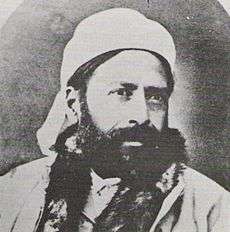Ibn-i-Asdaq

Mírzá `Alí-Muḥammad-i-Khurásání (Arabic: ميرزا علي محمد خراساني; died 1928), known as Ibn-i-Aṣdaq, was an eminent follower of Bahá'u'lláh, the founder of the Bahá'í Faith. He was appointed a Hand of the Cause and identified as one of the nineteen Apostles of Bahá'u'lláh.
Ibn-i-Asdaq was addressed by Bahá'u'lláh as Shahíd Ibn-i-Shahíd (Martyr, son of the Martyr). He was the son of a distinguished martyr of the Bábí movement, and himself requested several times to give his life up for the Bahá'í Cause. The response by Bahá'u'lláh was, "Today, the greatest of all deeds is service to the Cause... This martyrdom is not confined to the destruction of life and the shedding of blood. A person enjoying the bounty of life may yet be recorded a martyr..." (Eminent Bahá'ís, p. 172).
In 1920, Ibn-i-Asdaq and Ahmad Yazdani, brought the Tablet to The Hague from ‘Abdu’l-Bahá to the Central Organisation for Durable Peace in The Hague.[1]
Ironically, Ibn-i-Asdaq lived a long life of service, dying in 1928. He was one of the few Apostles to live into the time of Shoghi Effendi as the Guardian.
Background

Family
As his name implies, Ibn-i-Asdaq was the son of Ismu'lláhu'l-Asdaq of Khurásán, also known as Mullá Sádiq-i-Muqaddas. Mullá Sádiq together with Quddús and Mullá Alí Akbar-i-Ardistání were the first three Bábís known to suffer persecution for their faith on Persian soil. He was also a survivor of the Fort Tabarsi engagement in Mázindarán (1848).
Ibn-i-Asdaq's daughter, Ruha Asdaq, later wrote a book about her pilgrimage experiences called One Life One Memory.
Notes
- ↑ de Vries 2002, pp. 106–110
References
- `Abdu'l-Bahá (1997) [1971]. Memorials of the Faithful (Softcover ed.). Wilmette, Illinois, USA: Bahá'í Publishing Trust. ISBN 0-87743-242-2.
- Balyuzi, Hasan (1985). Eminent Bahá'ís in the time of Bahá'u'lláh. The Camelot Press Ltd, Southampton. ISBN 0-85398-152-3.
- Harper, Barron (1997). Lights of Fortitude (Paperback ed.). Oxford, UK: George Ronald. ISBN 0-85398-413-1.
- de Vries, Jelle (2002). The Babi Question You Mentioned--: The Origins of the Baha'i Community of the Netherlands, 1844-1962. Peeters Publishers. ISBN 978-90-429-1109-3.
- Effendi, Shoghi (1932). The Dawn Breakers/Nabíls Narrative. Willmet, Illinois: Bahá'í Publishing Trust. ISBN 0-87743-010-1.
